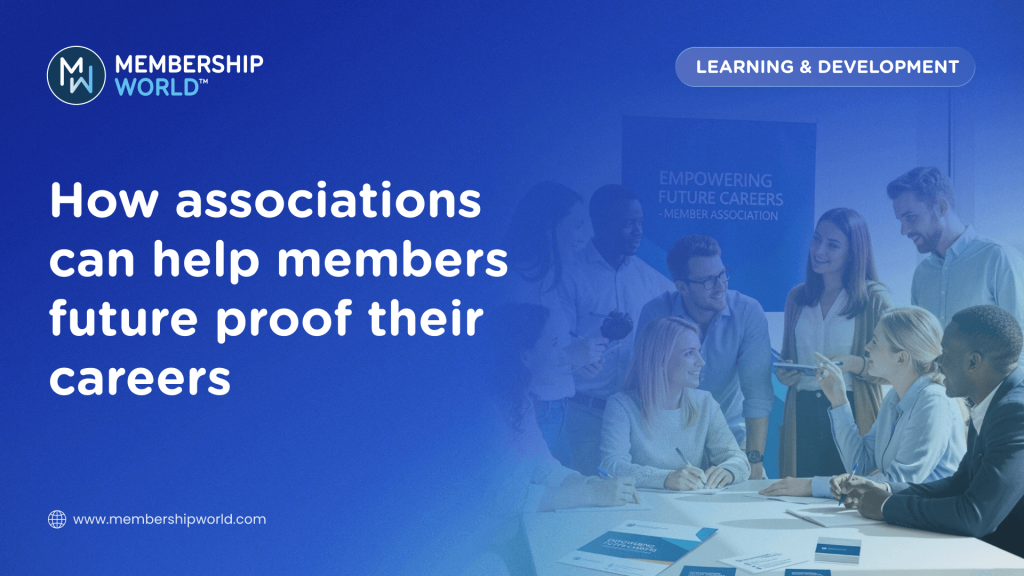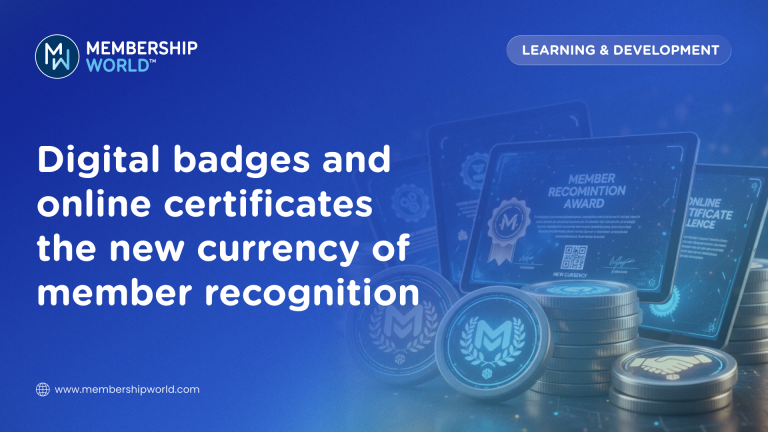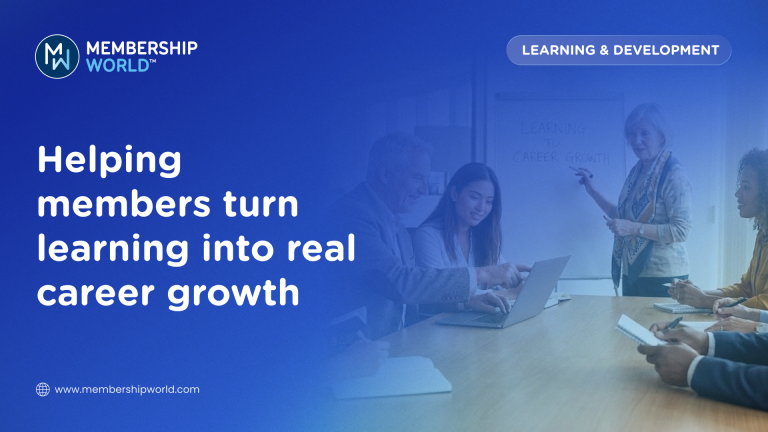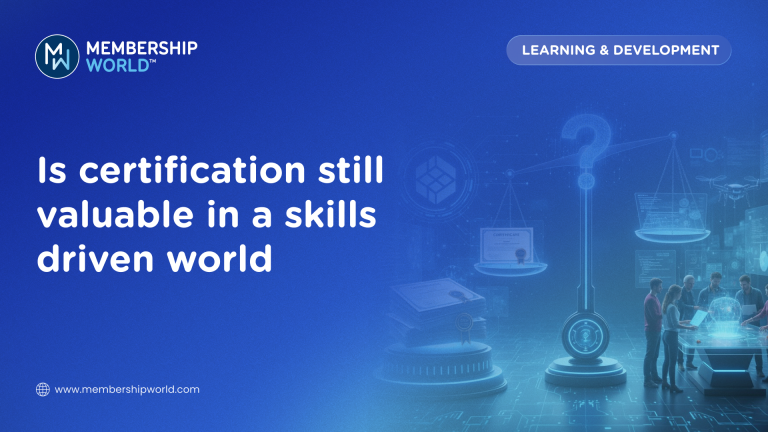
The workplace is changing faster than ever. New technologies, shifting industries, and evolving expectations mean that professionals can no longer rely on a single degree or certification to last an entire career.
For members, the question isn’t just “How do I grow now?” It’s “How do I stay relevant tomorrow?”
This is where associations can play a powerful role. Beyond providing community and advocacy, associations are uniquely positioned to help members future proof their careers — giving them the skills, recognition, and networks to stay competitive in uncertain times.
TLDR
- Careers are no longer linear; constant change makes lifelong learning essential.
- Associations can future proof members’ careers by:
- Offering continuous upskilling opportunities.
- Providing recognised certifications and digital badges.
- Building mentorship and peer networks.
- Curating resources that cut through information overload.
- Acting as trusted guides in uncertain industries.
- Members who see career advancement through their association are far more likely to renew and recommend membership.
Why future proofing matters now
The “future of work” isn’t in the future anymore. It’s here.
- Automation and AI are reshaping roles in almost every industry.
- Remote and hybrid work are changing how teams collaborate.
- Skills half-lives are shrinking — many technical skills expire in just 3–5 years.
- Younger generations expect rapid growth opportunities and visible recognition.
For members, this means standing still isn’t an option. And for associations, it means offering learning isn’t just a “nice-to-have” — it’s central to your relevance and value.
How associations can help members stay ahead
Here are five ways associations are already (or could be) helping members future proof their careers.
- Continuous upskilling and reskilling
Instead of offering only annual conferences or one-time courses, associations can provide ongoing opportunities to build new skills.
- Short online courses that fit into busy schedules.
- Webinars addressing emerging trends in real time.
- Learning pathways that evolve as industries change.
Example: An IT association might create a rolling series on cybersecurity updates, ensuring members are never left behind by the latest threats.
Why it matters: Members see their association as a constant source of growth — not just a once-a-year resource.
- Recognised credentials and digital badges
Learning is powerful, but recognition multiplies its impact.
Associations can offer:
- Certificates for completing major programs.
- Digital badges that members display on LinkedIn.
- Micro-credentials for short, focused skill-building.
These recognitions signal to employers and peers that a member’s skills are verified and current.
Why it matters: Members gain not just knowledge, but credibility — making the association central to their career identity.
- Mentorship and peer networks
Not all learning happens in classrooms or LMS platforms. Some of the most valuable insights come from peers.
Associations can build structured and informal systems that connect members:
- Mentorship programs pairing early-career professionals with seasoned experts.
- Peer groups where members share challenges and solutions.
- Communities of practice around specific topics.
Why it matters: Members don’t just get knowledge; they gain trusted relationships that can support them through career transitions.
- Curating resources in an age of overload
The problem today isn’t a lack of information — it’s too much. With endless online courses, articles, and videos, members struggle to know what’s credible.
Associations can step in as curators, offering:
- Carefully selected resources that cut through the noise.
- Guides and toolkits summarising what matters most in the industry.
- “Learning playlists” that combine association content with vetted external resources.
Why it matters: Members save time and feel confident knowing their association is steering them toward what’s truly valuable.
- Acting as trusted career partners
Above all, associations can position themselves not as providers of content, but as career partners.
That means:
- Helping members identify career paths within their field.
- Offering career coaching or advising services.
- Hosting job boards that connect learning with opportunity.
- Supporting both technical and soft skills needed for advancement.
Why it matters: Members stay because they see the association as essential to every stage of their career — not just early training or certification.
The business case for associations
Future proofing members’ careers isn’t just altruistic. It’s smart business for associations too.
- Retention: Members who credit their career success to the association are far more likely to renew.
- Recruitment: Younger generations, especially Gen Z, are actively looking for career growth opportunities.
- Revenue: Paid certifications, micro-credentials, and advanced courses open new income streams.
- Relevance: In a crowded online learning market, associations stand out as trusted sources tied directly to industry standards.
Challenges associations need to navigate
Helping members future proof their careers does come with challenges:
- Keeping content current in rapidly changing fields.
- Balancing depth and accessibility — not everyone has time for a full course.
- Choosing the right platforms — LMS systems, digital credentialing tools, and analytics all need to work together.
- Demonstrating ROI — proving to members that learning leads to tangible career outcomes.
Associations that openly tackle these challenges build even stronger trust.
What the future looks like
Looking ahead, we can expect associations to play an even bigger role in career resilience. Some possibilities include:
- AI-driven learning paths tailored to each member’s skills and goals.
- Stackable credentials that build over time toward advanced qualifications.
- Cross-industry programs as professions overlap more in a digital world.
- Global career recognition through partnerships with international associations.
- Integrated job and learning ecosystems where training, certification, and opportunities are connected seamlessly.
The association of the future isn’t just a membership organisation. It’s a career growth platform.
Final thoughts
Members don’t just want a newsletter or a conference anymore. They want assurance that their careers will remain viable and competitive in a changing world.
Associations that step into this role — providing continuous learning, recognition, peer networks, and trusted guidance — become indispensable.
Future proofing isn’t just about protecting jobs. It’s about helping members unlock their potential, no matter what changes come next.
How is your association helping members future proof their careers?
👉 Do you offer digital badges, mentoring, or curated resources?
👉 Are you exploring AI-driven learning or stackable credentials?
👉 What challenges are you facing in meeting these needs?
The conversation continues in the Membership World Community. Let’s share ideas, challenges, and innovations to ensure our members are ready for the future.



